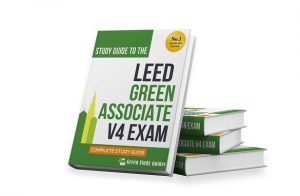LEED AP ID+C Exam Format and Practise Questions
The LEED AP® exam is comprised of two parts, the LEED® Green Associate™ exam and the LEED AP with specialty exam. Each part contains 100 randomly delivered multiple choice questions that to be completed in 2 hours. Total seat time for the LEED AP ID+C exam will be 4 hours and 20 minutes including a tutorial and short satisfaction survey.
Candidates who have already passed the LEED Green Associate Exam can register for the specialty-only portion of the exam, and do not need to sit for the entire composite exam. Please be aware that the option to take the combined exam (LEED GA And LEED AP ID+C) in one sitting is not available in all languages and at all test centers.
Download LEED GA Exam Preparation Guide
If you are planning to take LEED Green Associate Exam and LEED AP ID+C exam together, be prepared to spend 4 hours and 20 minutes to the entire process. Total exam time is broken out as follows: an optional 10 minute tutorial, the 2-hour LEED Green Associate exam, the 2-hour specialty exam, and an optional 10-minute exit survey.
LEED AP® ID+C Specialty Exam
This LEED AP ID+C exam is designed to test the knowledge and skills necessary to participate in the building design process, to support and encourage integrated design, and to streamline the application and certification process.
10 numbers of LEED AP Interior Design + Construction practice questions are listed below with answers and explanations.
The items are provided for your convenience to allow you to better familiarize yourself with the format and general content of items on the LEED AP® Interior Design + Construction exam.
1. A 2,500 SF (233 m2) store pursuing LEED ID+C: Retail is located near a bicycle network. All of the following would design decisions would contribute to earning LT Credit Bicycle Network EXCEPT:
A. 2 short-term bicycle storage spaces located within 100 feet of the employee entrance
B. 2 long-term bicycle storage spaces located within 100 feet of the main entrance
C. Bicycle route map posted on the front window for employees and customers
D. On-site supplies for bicycle repair
Answer: A. 2 short-term bicycle storage spaces located within 100 feet (30 meters) of the employee entrance. Short term storage must be located near any main entrance. An employee entrance would not be accessible to customers and is thus not a main entrance.
2. A 6-story office space will be located in an arid region. Installing occupancy sensors would not impact which credit?
A. EQ Prerequisite Minimum IAQ Performance
B. EA Credit Optimize Energy Performance
C. EQ Credit Enhanced IAQ Strategies
D. EQ Credit Thermal Comfort
Answer: C. EQ Credit Enhanced IAQ Strategies Occupancy sensors are not part of monitoring outdoor air delivery.
3. A 10,000 SF tenant space is located in a 150,000 SF high-rise building. The project building includes underground parking and an attached parking deck. The tenant shares the parking with other building tenants. What would the certification fees be based on?
A. Project gross floor area, excluding parking
ID+C project fees exclude parking areas.
B. Building gross floor area, excluding parking
C. Project gross floor area, including parking
D. Building gross floor area, including parking
Answer: A. Project gross floor area, excluding parking ID+C project fees exclude parking areas.
4. A 10-story office building will have many tenant spaces. A building owner and engineer are reviewing potential building automation systems for advanced energy metering to allow the owner to educate tenants about the energy use their tenant space is using. The team has found a system that uses a wireless network, will store all meter data for at least 36 months, and can be remotely accessible. What else will need to be included for EA Credit Advanced Energy Metering?
A. Each floor of the building must be submetered separately
B. Energy meters must record data hourly, daily, monthly, and annually
C. Each tenant space must be submetered
D. Each tenant must reduce their energy use by at least 10% for any individual energy end use
Answer: B. Energy meters must record data hourly, daily, monthly, and annually
– The meters must record data at these frequencies at least.
– The meters must also be permanent and record consumption and demand.
– The data must have remote access.
– Data collection must be networked (wireless, wired, cellular).
– Data collection must be stored for at least 36 months.
5. A 50,000 SF (4,645 m2) retail project has a baseline parking capacity of 4 parking spaces / 1,000 SF (4.3/100 m2) from the ITE handbook. The project will earn 1 point under LT Credit Surrounding Density and Diverse Uses and 1 point under LT Credit Access to Quality Transit. Which is the maximum number of parking spaces the project can have and still earn LT Credit Reduced Parking Footprint?
A. 200 spaces
B. 80 spaces
C. 40 spaces
D. 120 spaces
E. 160 spaces
Answer: D. 120 spaces
– A 20% reduction is required for projects that DO NOT earn points under LT Credit Surrounding Density AND Diverse Uses and LT Credit Access to Quality Transit.
– A 40% reduction is required for projects that DO earn points under LT Credit Surrounding Density OR Diverse Uses and LT Credit Access to Quality Transit.
50,000 SF / 1,000 SF = 50 X 4 spaces = 200 space baseline
200 spaces X 40% = 80 space
REDUCTION = 120
6. A 50,000 SF (4,645 m2) retail project has a baseline parking capacity of 4 parking spaces / 1,000 SF (4.3/100 m2) from the ITE handbook. The project will earn 1 point under LT Credit Surrounding Density and Diverse Uses but not earn LT Credit Access to Quality Transit. The project includes off-street parking. How many preferred parking spaces for carpools must the project includes for LT Credit Reduced Parking Footprint?
A. 3 spaces
B. 5 spaces
C. 6 spaces
D. 4 spaces
Answer: C. 6 spaces
50,000 SF / 1,000 SF = 50 X 4 parking spaces = 200 space baseline200 space baseline from the ITE handbook X 60% (40% reduction)
= 120 total spaces
120 spaces X 0.5% preferred parking = 6 spaces
7. Achieving the greatest effectiveness in cost and environmental performance requires that every issue and every team member be brought into the project at which of the following points?
A. Design and construction
B. Preliminary LEED review
C. Occupancy, operations, and performance feedback
D. Discovery
Answer: D. Discovery. During the Discovery phase is when everyone needs to gather their ideas and consider synergies across LEED credits.
8. Achieving the greatest effectiveness in cost and environmental performance requires that every issue and every team member be brought into the project at which of the following points?
A. Preliminary LEED review
B. Discovery
C. Occupancy, operations, and performance feedback
D. Design and construction
Answer: B. Discovery. During the Discovery phase is when everyone needs to gather their ideas and consider synergies across LEED credits.
9. After an office space was completed in June, a project team took daylight measurements in all regularly occupied spaces. Which action must occur for the project to earn EQ Credit Daylight?
A. The team must submit a list of compliant spaces with their annual summary values for sDA and ASE.
B. A daylight modeler must be hired to confirm the results of the measurements.
C. A narrative must be written listing the compliant spaces with their calculated illuminance values.
D. A second set of measurements must be taken in October to determine compliant floor areas.
Answer: D. A second set of measurements must be taken in October to determine compliant floor areas.
10. After project registration you find a credit the project is attempting is listed as applicable under the ‘Applicable credits’ section of the Interpretations database. What must the project team do?
A. Review the Addenda database
B. Submit a Project CIR
C. Resubmit the credit
D. Review the interpretation and apply it if it makes sense to do so
Answer: D. Review the interpretation and apply it if it makes sense to do so






